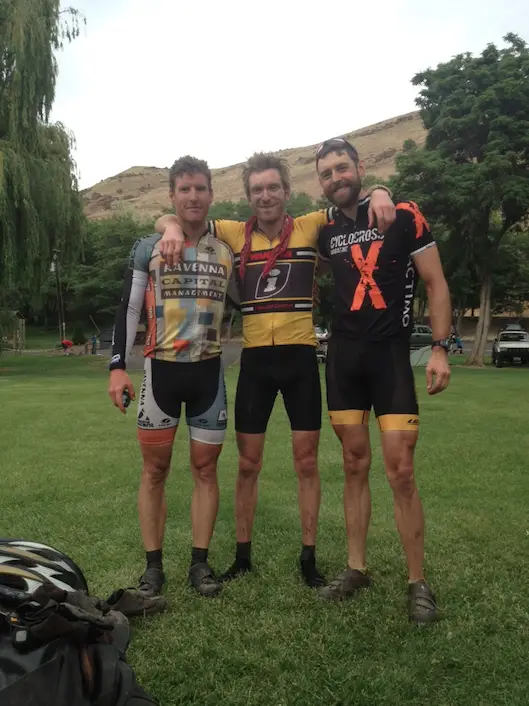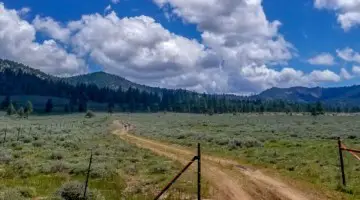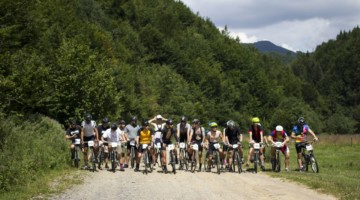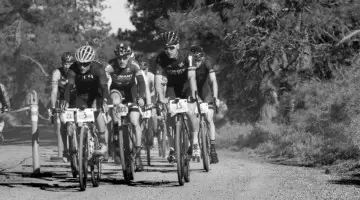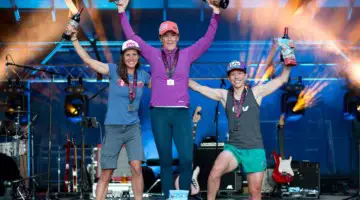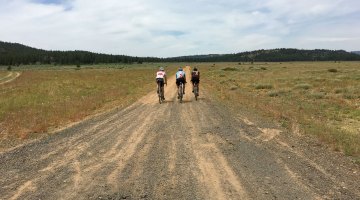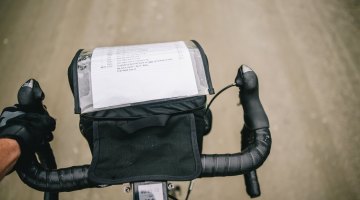360 miles of gravel? Cyclocross Magazine contributor Robbie Carver tackled the epic ride and lived to tell the story…
At nine o’clock at night, in the growing dusk of a Portland summer night, my two buddies—Davis and Ric—pulled up to my garage in a rented mini-van, nearly two hours later than our agreed-upon departure. Ric, a strong Seattle rider with the build of a wrestler, could only shrug his shoulders. Davis, more greyhound than man, only smiled. With us, we knew, this is just how such trips start. I shrugged in return, and we stuffed my Surly Long Haul Trucker, with new 42mm file treads and rear panniers, in alongside their rigs.
It was the Thursday before Memorial Day, and we were following a host of less-than-sane cyclists who had, earlier that day, boarded the Amtrak train, rigs and bags in tow, and headed to Klamath Falls, Oregon, a tiny town just north of the California border, tucked just east of the Cascade range. In the morning we would all set off on the first annual Oregon Outback, a 360-mile, 75% gravel romp north to the Columbia River.
The Outback came from the folks at Velodirt, the Portland-based gravel ride organizers who, for the past few years, have been putting on single-day gravel-grinders in the hills and plains of Oregon. These rides, always semi-legal, wholly unsanctioned, completely self-supported, are known for their epic difficulty, amazing views, and fantastic company. A few things are guaranteed on a Velodirt ride: questionable road choices, ridiculous gravel, flat tires, and some of the best riding this state has to offer.
“I had been trying to put a route together with as much dirt as I could, with shortest way across the state and the least climbing,” said Donnie Kolb, the man behind Velodirt and the name most people praise when rounding a hilltop corner and seeing a broad vista of the Oregon volcanoes marching down the horizon, or curse three hours into a sandy, headwind slogfest.
Here’s how it worked: Velodirt supplied the date, gps route, cue sheets, and minimal information on water and camping options. The rest was up to us.
“It’s hard to find that balance between giving people every bit of information and keeping a bit of adventure in it,” Donnie said. “I think we mostly toed that line.”
After passing a few weary hours sleeping on the asphalt of a high school parking lot – to be woken by the groundskeeper spraying weedkiller inches from our heads—we set off for where somewhere between a hundred, and a hundred-fifty (the number is sure to grow with legend) were gathering. An argument between Google Maps and the Rental Car drop-off location, however, meant we missed the official start and Donnie’s customary “if anyone asks, y’all just happen to be on the same road at the same time,” speech, which I’m sure was slightly undermined by the local TV crew showing up to film the send-off.
“It’s really hard to fly under the radar now than we used to,” he said. “But people were really stoked; the locals were really welcoming. I was impressed with how Amtrak handled everyone. To me, it’s really cool that we can do this stuff and not have much negative reaction.”
We tacked on to the back of a herd of bikes, as bulkily bovine as any cattle, moving at roughly the same pace. Knowing I’d be spending the next three days with two hairy, sweaty men, I pulled up next to a wonderful young woman—riding flat pedals and an old steel 26’er—to get some pleasant conversation about her Ph.D. thesis and oceanography, girding myself before the inevitable male-descent into fart and penis jokes. It was a lovely five minutes.
“I knew pretty early on that if this whole route worked out, that I wanted to something like what we just did,” said Donnie. “It’s been a really big undertaking; it was a lot of work. It was pretty nerve-wracking, a lot of people didn’t quite understand what they were getting into.”
There was, near literally, every type of bike and biker I could imagine. 80’s-era randonneur bikes with flat pedals, 29’ers decked out with Revelate and Porcelain Rocket frame bags, even a neon-green cargo bike. Riders and groups each had their own agenda—some, like us, planned to complete the Outback in three days, averaging 120 a day, riding dawn to dusk; the smarter of the lot were shooting for four, five or six days (in fact, I believe some are still out there), opting for the crazy idea of actually enjoying themselves with long, languid hours at campsites, swimming in rivers, and getting tanked around a fire.
Donnie, usually one to take his time (when he scouted the route the year before with a crew of friends, they took a full week), decided to shoot for three days. “I had never bike-packed a hundred miles in a day, and I did it 3 days in a row. Everything went to plan,” he laughed, “it just turned out I didn’t like my plan that much. To me it wasn’t a fun way to do it.”
Donnie was riding a mostly-stock Surly Ogre, with Chris King parts. “I think it’s pretty much ideal for rides like this,” he said, “unless you’re trying to go really fast. 2.2 inch tires. It’s a good standard for Oregon. Anything in the rigid 29er will work pretty well. Ira will never ride a bike like that, but he wants to fucking suffer the whole time.”
Ira. Ira Ryan, the winner of the seven-odd riders who had decided to “race” this ride, straight through the night, and complete it in a single go. He did it in 28 hours. While everyone else was loaded down with camping gear, extra food, stoves and tents and water bladders, these guys had a handlebar bag and a spare vest. My Surly had to have weighed in at 60 pounds, if I’m being kind. Ira’s bike? 29lbs, fully loaded.
“My bike was either going to be the ultimate weapon,” he said, “or the fastest way to complete implosion.”
Ira is a custom frame builder who, along with builder Tony Periera, recently launched Breadwinner Cycles, building an array of custom, TIG-welded steel bikes in all the major disciplines. For the Outback, Ira raced a beautiful Breadwinner “B-Road”, their response to the growing gravel market. Stay tuned for a full profile of his race-winning bike.
“The B-Road is close to our ’cross bike, but we made a couple of slight tweaks for gravel racing. We lowered the bottom bracket drop by four millimeters, which really makes a difference. We used oversized Columbus tubing, but not too big—we designed it to be stiff and responsive, but not so much that it beats you up.”
Ira’s B-Road had a couple interesting personal touches. He gutted a ten-speed down-tube shifter and managed to fit the guts of an 11-speed TT shifter inside it, “to my knowledge, it’s the only 11-speed down-tube shifter in existence.” He drilled out the levers on his TRP Hylex hydraulic breaks, “for style”, and rocked a 90’s-era Sella Italia Flight because he liked the shape better than the current models. He custom made his saddle bag, smaller than those on offer by Revelate, using 1000 denier cordura, leather upper and bottoms, nylon straps and toe straps, “the duct tape of the cycling world.” He road without a GPS, choosing to rely on maps and a cue sheet.
“I like the simplicity,” Ira said. “It might not be the raciest build, but for something like the Outback, when you’re hundreds of miles away from anything, you want reliability and fixability.”
The first 70-odd miles of the ride were on a rails-to-trails path that appeared to have been some politician’s pet project in the nineties, and then completely forgotten about since. While the trail wound through idyllic farmland and beautiful, dense forest, the surface itself was some of the most challenging terrain I’ve ever taken my Surly on.
“The first 90 miles, I used so much energy,” said Ira. “My whole body was wrecked, it was like a ’cross race for 90 miles. You’re just cooked.”
While the elevation gain was minimal, the trail was often overgrown, with large pumice rocks making a bouncy-castle out of my rear end, and soft almost-gravel that swished and swooshed beneath my tires. I often gazed longingly on those on 2.1s, rocking serious tread. However, even my file treads had more bite than Ira’s 700×38 Panaracer Pasela Tourguard’s. As we road, my buddies and I had to laugh at some of the tracks in the sand ahead of us, which looked more like the path of a drunken snake trying to make it’s way across the road than the lines of the fastest riders.
“The tires were a little wishy-washy in the loose stuff,” he admitted, “but I’m used to the inappropriateness of gear and terrain from cyclocross—this is normal! You just have to let it go, and let the bike go where it likes. Cursive, it’s a lost art.”
From there, the route continued to head north, giving us as many names for gravel as Eskimos have for snow. “The range of terrain was crazy. It blew me away. Railroad, pumice dust, crushed limestone. The dust. God, that was the worst.”
The dust came on the second day, after we made the previous day’s 120 miles, gorged ourselves on the football-sized steaks at the Cowboy Dinner Tree—steaks so large that even a century on loaded touring bikes couldn’t generate an appetite big enough to finish—and camped with twenty-odd other riders, gypsy style, in the public park of Silver Lake. It was past the long, dead straight gravel roads of Castle Rock (“Soul Crushing” said Ira), and into the volcanic, pine-laden region of the Deschutes. Deep red, as fine as silt and inches deep, the “Deschutes dust” just about finished us off – it put the “grind” in Gravel Grinder, but made the paved descent into Prineville all the sweeter.
We pulled into Prineville, hot and dusty and ready for as much junk food as we could pound, at about six p.m. on the second day. Ira had pulled in at 11 the previous night, questioning whether he could keep going. “I thought, no way. My knees are cooked. I’m so sick of bars. It was at the point that I was just gagging. I just sat there for a while. But then I thought, OK, I’m warm. Take some Advil, get some coffee, just go another ten miles. I just took it in small bites.”
Ira road through the night, up the long, beautifully graded paved climb into the Chococo National Forest, bombing down the gravel descent on the reverse side with a Nightrider 1200 helmet light, and crossed the five-odd streams that nearly sent my buddy Davis ass over teakettle when he tried to power through it on an old Jake-the-Snake with front and rear panniers. It’s been a long time since I’ve laughed that hard.
“It was funny to see people’s photos, and go—woah, that’s what that part looked like,” said Ira. “I like the experience of watching the sun rise, sun set, sun rise again. That’s the best motivation.”
I’m going to skip talking about the final sixty miles of the ride, along the high plains past Shaniko, which exists in it’s own special circle of hell (but, thankfully, had two angels waiting for us with cold beers at the end to cheer us into the final descent), and which Donnie, devil that he is, skipped by hitching a ride.
All said and done, the ride was an incredible experience, one that’s hard to capture in words or pictures, though I encourage you to check out the many blogs (check out Ira’s report here, and Velodirt’s compilation here) and Instagram feeds that have tried. There is no sweeter way to earn the views of the Cascades, or the beer at the end of the day, or the dip in the Deschutes River after 360 hard-fought miles, than to grind it out with a couple of buddies, or a host of turtle-slow party-ers, or in a solo-bid to prove to yourself you can do something so mind-numbingly stupid in one go.
I’d like to say that, when I do it next year, I’ll wisen up and take my time: three days seems, in reflection, the worst possible amount of time to attempt such a ride. It was too fast to be able to laze around the campfire, or sleep late into the morning; it was too slow to gain the glory and respect of those who gunned it start to finish. But, let’s be honest: were I to do it again, even knowing that four, possibly five days would be the most fun, offer the most laughs and experiences and warm-heartedness, I’ve proven time and again I’m just not that smart: I’m just a bit too much like Ira.
“I’m such a sucker for the romanticism of touring,” he said, “but the reality is I’m a little bit like a dog off leash—just get the ball!”
Ira did it in 28 hours, so naturally I wonder if I can do it in 27. Tackle me if I even begin to try.
“We will do this every year,” said Donnie. “The same Friday before Memorial Day. My next project is Oregonbikepacking.com. The idea is to have around 10 bike packing routes around the state, so that there is effectively a resource, it’ll be free.”
Latest posts by robbie (see all)
- Lars van der Haar Repeats at World Cup Valkenburg; Powers Ninth – Men’s Elite Race Report, Updated: Full Results - October 20, 2014
- Nys Again Crowned King of Vegas, Lars van der Haar, Jeremy Powers Podium – Brief Report, Full Results - September 10, 2014
- What Makes a Winning Gravel Grinder Bike? Oregon Outback Winner Ira Ryan’s Breadwinner - June 3, 2014













